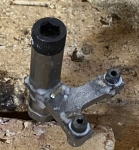Hi Gary
practice is the only way to improve silver soldering and watching the flux change state is the cheapest way because you can do this without using solder on different scrap pieces of material just to get use to the temperature and flux change. Then when confidence in this the solder can be introduced.
Any questions please ask.
The Home Engineer


 LinkBack URL
LinkBack URL About LinkBacks
About LinkBacks



 Reply With Quote
Reply With Quote





Bookmarks